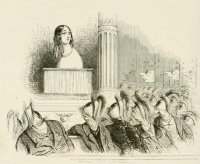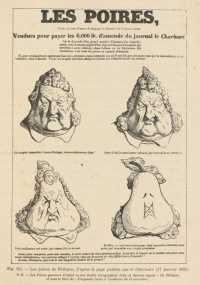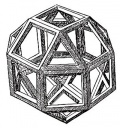Metamorphosis
From The Art and Popular Culture Encyclopedia
| Revision as of 08:23, 4 February 2023 Jahsonic (Talk | contribs) ← Previous diff |
Revision as of 08:35, 4 February 2023 Jahsonic (Talk | contribs) Next diff → |
||
| Line 1: | Line 1: | ||
| {| class="toccolours" style="float: left; margin-left: 1em; margin-right: 2em; font-size: 85%; background:#c6dbf7; color:black; width:30em; max-width: 40%;" cellspacing="5" | {| class="toccolours" style="float: left; margin-left: 1em; margin-right: 2em; font-size: 85%; background:#c6dbf7; color:black; width:30em; max-width: 40%;" cellspacing="5" | ||
| | style="text-align: left;" | | | style="text-align: left;" | | ||
| + | "Softening quickly in the waters quiet depth, their wood was changed to flesh, the curving prows were [[Metamorphosis|metamorphosed]] into human heads, blades of the oars made feet, the looms were changed to swimming legs, the sides turned human flanks, each keel below the middle of a ship transformed became a spine, the cordage changed to soft hair, and the sail yards changed to arms." --''[[Metamorphoses]]'' by Ovid, Brookes More translation | ||
| + | <hr> | ||
| "When they had eaten and drunk to their hearts' content, [[Circe|she]] waved her [[wand]] over them, and at once the poor wretches were [[shapeshifting|changed]] into grunting [[pig]]s, which she shut up in pigsties and threw acorns and other food fit for swine before them. Although thus transformed and covered with bristles, they still retained the [[human mind]]."--''[[Odyssey]]'' | "When they had eaten and drunk to their hearts' content, [[Circe|she]] waved her [[wand]] over them, and at once the poor wretches were [[shapeshifting|changed]] into grunting [[pig]]s, which she shut up in pigsties and threw acorns and other food fit for swine before them. Although thus transformed and covered with bristles, they still retained the [[human mind]]."--''[[Odyssey]]'' | ||
| <hr> | <hr> | ||
Revision as of 08:35, 4 February 2023
|
"Softening quickly in the waters quiet depth, their wood was changed to flesh, the curving prows were metamorphosed into human heads, blades of the oars made feet, the looms were changed to swimming legs, the sides turned human flanks, each keel below the middle of a ship transformed became a spine, the cordage changed to soft hair, and the sail yards changed to arms." --Metamorphoses by Ovid, Brookes More translation "When they had eaten and drunk to their hearts' content, she waved her wand over them, and at once the poor wretches were changed into grunting pigs, which she shut up in pigsties and threw acorns and other food fit for swine before them. Although thus transformed and covered with bristles, they still retained the human mind."--Odyssey "It was apparently owing to my addiction to couches that Brahma conceived the idea of confining my soul in such a piece of furniture."--The Sofa: A Moral Tale (1742) by Claude Prosper Jolyot de Crébillon "One morning, when Gregor Samsa woke from troubled dreams, he found himself transformed in his bed into a horrible vermin."--The Metamorphosis (1915) by Franz Kafka Thetis: So many women, and all these transformations and disguises he invents in order to seduce them. Sometimes a shower of gold, sometimes a bull or a swan. Why, once he even tried to ravish me disguised as a cuttlefish. --dialogue on Zeus's promiscuity in the film Clash of the Titans (1981) |


|
Related e |
|
Featured: |
Metamorphosis is a biological process by which an animal physically develops after birth or hatching, involving a conspicuous and relatively abrupt change in the animal's form or structure. Some insects as well as other species undergo metamorphosis, which is usually (but not always) accompanied by a change of habitat or behaviour.
Contents |
Metamorphosis as a trope
Greek mythology
Metamorphoses of any kind have been popular since Circe in Odysseus and Ovid's Metamorphoses. Metamorphosis is a frequently used horror trope which can take many forms: crosses between humans and plants, objects and humans, etc…
Edith Hamilton gathered numerous examples of metamorphoses in her book Mythology (1942).
Renaissance
In Hypnerotomachia Poliphili, Francesco Colonna describes the transformation of seven nymphs into trees in the presence of the god Jupiter. A woodcut[1] illustrates the process:
- "They then transformed themselves into green trees of transparent emerald, covered with bright blue flowers, which bowed devoutly to the high god. The last one was entirely turned to a tree, her feet becoming roots; the next, all but her feet; the third, all but the part from the waist to the arms; and so on, successively. But the tops of the virginal heads showed that the metamorphosis would happen to each in turn." (Colonna 1999: 174)[2]
Enlightenment
A particular variety of metamorphosis is people turned into furniture. Two stories in which humans transform into chairs make use of this plot device: the French libertine novel The Sofa (1742) by Crébillon fils and the Japanese short story The Human Chair (1925) by Edogawa Rampo. In both stories a man becomes a sofa, in the former quite literally so (by a curse), in the latter, a man hides in sofa to feel the persons who sit in him.
20th century
The archetypical metamorphosis story is The Metamorphosis by Franz Kafka in which a man wakes up to find himself transformed into a vermin.
In cinema it has remained a popular trope, for example in The Little Shop of Horrors (1960) by Roger Corman a plant becomes a carnivore, and after it has eaten a number of people, the last buds of the plant open and reveal the faces of the people it has eaten.
See also
- Danae by Gustav Klimt
- Heliades' metamorphosis into a tree from Tableaux du temple des muses '
- Shapeshifting
- Transmogrification
- Metamorphoses
- Pygmalion (mythology)
- The Metamorphosis by Kafka
- List of films about possessed or sentient inanimate objects
- Machiavelli's Golden Ass
- Developmental biology
- Direct development
- Gosner stage
- Hypermetamorphosis
- Morphogenesis
- Metamorphosis of Plants by Goethe


